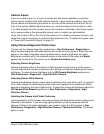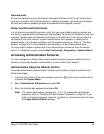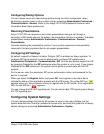
Avaya 1010/1020 User Guide 37
Configuring the DHCP Option
Specific configuration details of DHCP servers for use with this feature vary depending on
the DHCP server used and your environment. The scope of this section is limited to
describing the format of site-specific option 157.
An Avaya system can accept site-specific option 157 from the DHCP server if you configure
the option as a string with the following format:
“Avaya: server=<path>”
where <path> is one or more URLs separated by semicolons that specifies the location of a
configuration file. Supported protocols include TFTP, FTP, and HTTP. If the path contains
more than one URL, the Avaya system tries the URLs in the order listed and uses the first
file that exists.
Example:
If the path is:
http://example/config/fishtank.cfg;ftp://example/other/fishtank.cfg
the system attempts to obtain the configuration file fishtank.cfg from the web server at
http://example/config/fishtank.cfg. If the file does not exist at that location, the system
attempts to obtain the configuration from the FTP server at ftp://example/other/fishtank.cfg.
Note: If the server requires a username and password to access the file, for example to
log into an FTP server, you can include the user name and password in the URL.
For example:
ftp://<username>:<password>@example/other/fishtank.cfg
where <username> is the user name and <password> is the password required for
the login. The user name and password must not contain a semicolon.
Each URL can also contain the following escapes to make the configuration unique to the
system:
Escape Replacement Value
#M Replaced with the MAC address using the underscore character to replace the
colon between bytes. The MAC address resolves to a hexadecimal number with
lower case letters.
#S Replaced by the system model; passport.
#I Replaced by the assigned IP address.


















